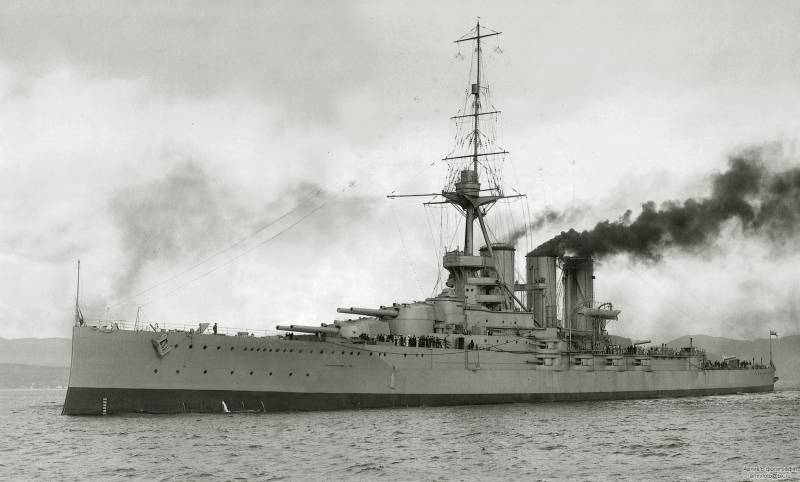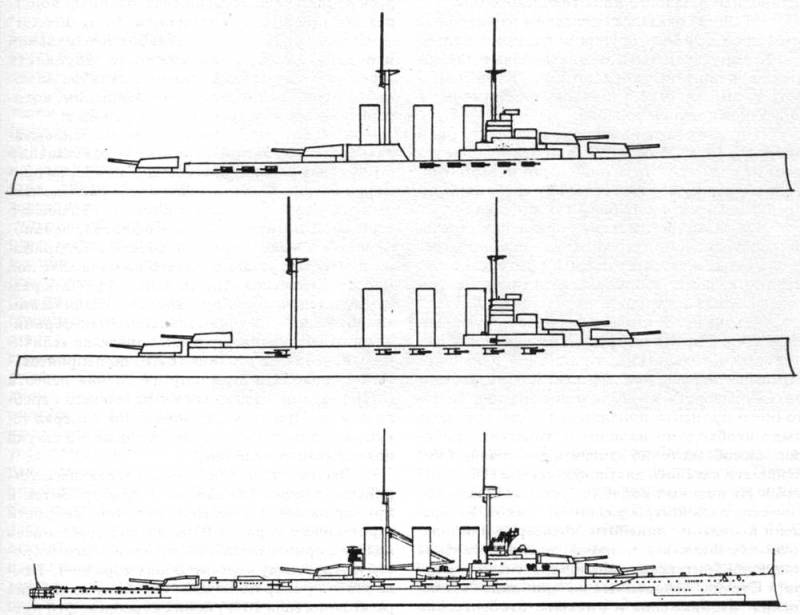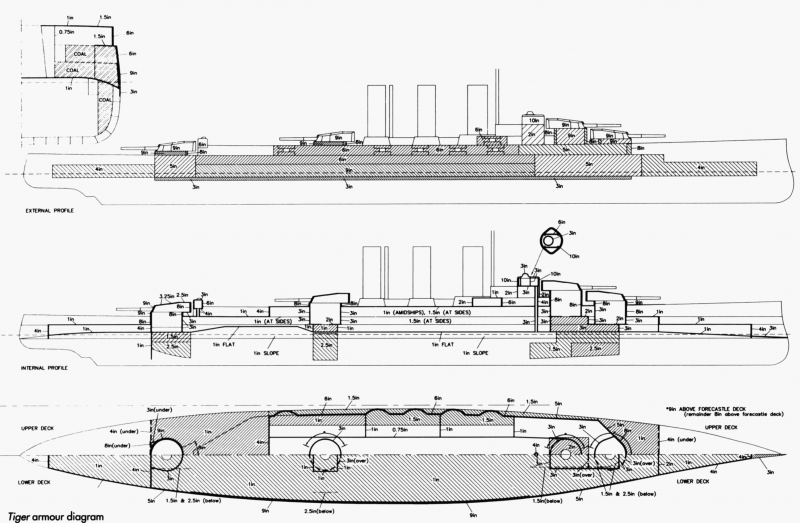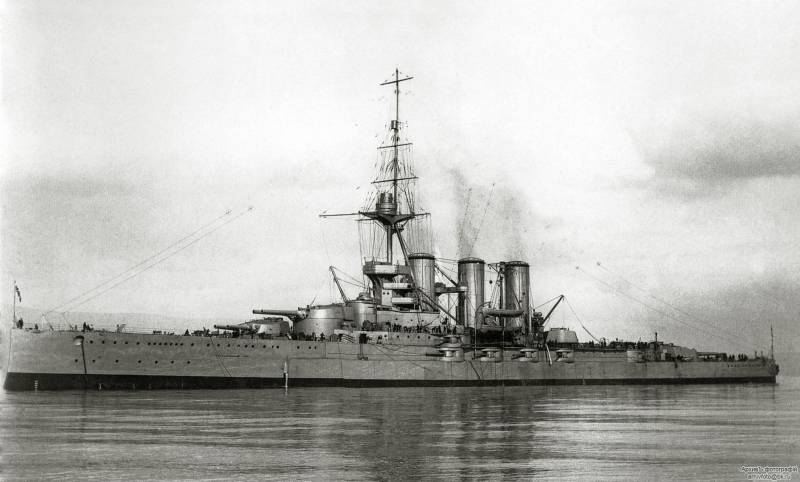Rifle battle cruisers. "Derflinger" against "Tager". H. 2
I must say that by the time the Tiger was being designed, the British gradually lost interest in the battlecruisers. Whatever John Arbetnot Fisher said about this, the weakness of the protection of these ships and the danger of opposing them to any ships with heavy guns became more and more obvious. Therefore, the shipbuilding program 1911 g provided for the construction of only one ship of this type, which was supposed to be created as an improved version of Queen Mary. However, the design of the Japanese "Congo" attracted the great interest of the British, if only because it was the first non-English warship armed with guns of a caliber over 305-mm.
Artillery
The same 343-mm / 45 tools that were installed on Queen Mary were used as the main caliber. When shooting heavy 635 kg shells were used, the initial velocity of which, apparently, reached 760 m / s. However, under the influence of the Congo, the British finally positioned the towers in a linearly elevated pattern. In this case, considered two options for the location of the main artillery caliber.
In one embodiment, by analogy with the "Congo", it was supposed to place a third tower between the boiler rooms and engine rooms. The second option involved the placement of aft towers nearby, by analogy with the bow. The first option was chosen, but you can only guess about the reasons. Most likely, the separation of the towers of the main caliber by a distance, which excludes their disruption by one projectile (as it happened with “Seidlits”), also played a role, and also, with such an arrangement of artillery, when firing directly into the stern, the impact of muzzle gases of the third towers on the fourth, obviously, minimized and generally negligible. Whatever it was, but the towers "Tiger" were placed on a "Congo" scheme.
Mine bombardment was also improved: the Tiger became the first British battle cruiser to receive the 152-mm gun. A series of battleships like the Iron Duke (also the first), which was being built simultaneously with the Tiger, was armed with the guns of the same caliber. I must say that on the mine side weapons heavy ships in England reigned confusion and reeling. D. Fisher believed that the smallest caliber would be enough for ships, relying on rate of fire. Officers, on the other hand, fleet legitimate doubts were already creeping in that one rate of fire would be enough. So, Admiral Mark Kerr proposed to use main caliber guns with shrapnel shells to repel the destroyers attacks, but subsequently changed his mind in favor of the 152 mm caliber based on the following considerations:
1. Despite the advantages of main-caliber guns when shooting at destroyers (this is also about centralized fire control), distracting them from the main goal in combat is unacceptable;
2. Water poles from falling 152-mm projectiles make it difficult for enemy artillery gunners to hurt and, possibly, destroy telescopic reticle;
3. The Japanese spoke extremely well of the "anti-mine" qualities of six-inch artillery;
4. All other countries creating dreadnoughts prefer a larger caliber than 102-mm.
As can be understood from the sources, the final decision was taken on 12 on April 1912 g, during a lengthy committee meeting of representatives from the artillery weapons department of the navy. In essence, it radically changed the concept of the anti-mine artillery of the British fleet.
Previously it was assumed that the ships should be installed as much as possible relatively small-caliber guns, and it would be quite normal to put them openly and not to protect them with armor. The main thing is not to keep the calculations constantly on these guns, they were supposed to be under the protection of armor and go out to the guns only when the threat of a torpedo attack arises. A large number of rapid-fire guns required numerous calculations, but here the British came to a “brilliant” conclusion - since during the artillery battle part of the open-standing mine artillery guns would be destroyed, then half of the staff of the crew would be enough to provide the remaining number of servants. In other words, the British battlecruisers, having 16 openly standing 102-mm, also had eight calculations for them.
However, now the situation has changed. First, the observation of the maneuvers of the Kaiser fleet convinced the British that the torpedo attack was now an indispensable element of the battle of the battleships. The point here, of course, is not so much the fact that the Kaiserlmarine was replenished with numerous high-speed destroyers (at speeds up to 32 knots), but that the Germans were constantly working out the tactics of using them in a battle of linear forces. This, coupled with the unimportant visibility conditions in the North Sea, led to the fact that the calculations could no longer be kept away from the guns, since a torpedo attack could be expected at any moment. The high speed of the new destroyers, coupled with the improved characteristics of the torpedoes, led to the fact that the calculations could simply not be in time for the guns. At the same time, the experience of the hostilities of the Russian-Japanese war irrefutably testified to the enormous losses of the settlements serving the guns that were not protected by armor.
As a result, it was decided to place fewer guns on ships (12 instead of 16), but at the same time place them in a protected dungeon and “equip” each gun with their own calculation (and not half the staff). It was assumed that this would not reduce the number of trunks in repelling a torpedo attack, since, obviously, the chances of surviving this attack on a protected gun are significantly higher than those who are standing openly. In addition, the reduction in the number of guns at least slightly offset the added weight from the installation of larger-caliber guns.
In addition to all the above reasons, it was taken into account that the 152-mm gun is the smallest artillery system in caliber, capable of hitting the attacker or stripping the torpedo attack with one liditnaya filling, if not sinking. . Strictly speaking, a six-inch projectile could actually cause such damage, although it did not guarantee this, but the shells of a smaller caliber had few chances to stop the destroyer “with one strike” at all.
Due to the above considerations, the Tiger received a dozen 152-mm / 45 Mk.VII guns that had separate loading and firing 45,4 kg shells with an initial speed of 773 m / s. The firing range was 79 cable. The ammunition included 200 projectiles per barrel, including 50 semi-armor and 150 high-explosive. Subsequently, however, it was reduced to 120 shells per gun, including 30 semi-armored, 72 high-explosive and 18 high-explosive tracer.
At the same time, as we said earlier, before the "Tiger" on the British battlecruisers, the mine artillery was located in the bow and stern superstructures, while the guns placed in the bow superstructure only on the "Queen Mary" received splinter protection (during construction), and the guns in the aft superstructure on all the cruisers stood open. On the Tiger, the 152-mm battery was housed in a protected casemate, the floor of which was the upper deck, and the ceiling was the forecastle deck.
On the one hand, one could say that the Tiger medium artillery was close in its capabilities to the 150-mm guns of German heavy ships, but this was not the case. The fact is that by installing six-inch guns and protecting them with armor “in the image and likeness” of the Germans, the British retained a very unsuccessful system of placing artillery grabs and supplying ammunition to them. The fact is that the Germans distributed artillery cellars of 150-mm cannons on their ships in such a way that the feed mechanism from one cellar provided with projectiles and charges one, maximum two 150-mm guns. At the same time, the British concentrated 152-mm artillery grabs in the bow and stern of the ship, from where they were fed into special corridors for the supply of ammunition, and already there, overloaded to special elevators and suspended arbors, were fed to the guns. The danger of such a design is “excellent” demonstrated by the German armored cruiser “Blucher”, which lost nearly half of its combat capability after a single large-caliber British projectile hit the corridor (although the Germans moved 210-mm projectiles of the main caliber and charges to it).
"Tiger" received two 76,2-mm anti-aircraft guns during construction, in addition, there were four more 47-mm cannons on the battle cruiser, but the torpedo armament was doubled - instead of two 533-mm torpedo tubes on the previous Tiger line cruisers four such devices with ammunition in 20 torpedoes.
Reservation
As we said earlier, the booking of two battlecruisers of the “Lion” type and the third - “Queen Mary” had no fundamental differences and, in general, repeated each other. However, the Japanese when creating the "Congo" went to the introduction of three fundamental innovations, which were not on the British battle cruisers:
1. Armored casemate for anti-mine guns;
2. A strip of 76-mm armor under the main armor belt, protecting the ship from hitting “diving” projectiles (that is, those that fell into the water at the ship’s side and, passing under water, hit it in the side below the armor belt);
3. The increased area of the main armored belt, thanks to which he defended not only the engine and boiler rooms, but also the feeding pipes and the cellar of the ammunition of the towers of the main caliber. The price for this was a reduction in the thickness of the armored belt from 229 to 203 mm.
The British themselves believed that the Congo’s body armor was superior to that of the Lion, but at the same time only two Japanese out of three were introduced to the Tiger. We have already spoken about the appearance of the last 343-mm British casebreaker for 152-mm guns above, and besides, 76 mm underwater protection was introduced on it, and it looked like that. At Lion, with a normal displacement of 229 mm, the armor belt was immersed in water on 0,91 m. At Tiger, only on 0,69 m, but then it was located below 76 mm of armor belt (or should it be written here - depth?) 1,15 m, and he covered not only the engine and boiler rooms, but also the areas of the towers of the main caliber. In general, such a belt looked like a very reasonable solution, increasing the security of the ship.
But alas, the main innovation of Japanese shipbuilders, namely the extension of the length of the citadel to the towers of the main caliber, even if this led to a certain decrease in its thickness, was ignored by the British. On the one hand, they could be understood, because even 229 mm, in general, gave more or less good protection only against 280-mm shells and, to a limited extent, against 305-mm, but on the other hand, the rejection of the Japanese scheme led to the fact that only the 127 mm armored plates protected the board in the areas of the supply pipes and the cellars of the ammunition. Considering the fact that the barbers of the Tiger’s main-caliber towers had a 203-229 mm thickness only above the armor-protected side, the supply pipes were protected by 127 mm armor and 76 mm barbet from enemy projectiles.
On the one hand, it seems that, in aggregate, such protection had the same 203 mm of armor, but in fact it was not so, because the spaced armor loses monolithic by its “arm tightness” (until a certain thickness is reached, approximately 305 mm. German 280- mm shell, hitting the area of the board, playfully punched 127-mm armor plate and even if it would have exploded after being hit in barbet, it would still be the total energy of the explosion and impact that broke it, filling the flow tube with hot gases, flame, shell fragments and breached by him In other words, at the main combat distances (70-75 kBT), the barbets of the Tiger main caliber towers, it can be said, did not have protection from any German heavy projectiles. In this respect, the Tiger’s defense was compared with the booking of Lion and Queen Mary. The only difference between them was that the front turrets of these cruisers had slightly better protection (127-152 mm) and aft ones slightly worse (102 mm), but everywhere there was only 76 mm barbet and the Tiger’s ammunition cellars were no less are vulnerable than his predecessors 343-mm.
Other vertical armor "Tiger", in general, is very little different from that of the "Queen Mary". We only note that the total length of the armor belt on the waterline (including the 127 mm and 102 mm sections) is higher for Tiger - only the very “tips” of the bow and the stern (9,2 m and 7,9 m, respectively) are left unprotected. The casemate had 152 mm protection, the 102-mm was traversed in the stern, and the 127-mm armor belt of the same height went to the barbet of the first tower. From here, the 127-mm armor plates were located at an angle, converging on the nose edge of the barbet of the first tower, facing in the nose. The towers appeared to have the same protection as Queen Mary, that is, 229 mm front and side plates, 203 mm rear plate and roof 82-108 mm thick, on the back bevels - 64 mm. Some sources indicate the thickness of the roof 64-82 mm, but this is doubtful, because it is completely unclear why the British would weaken the protection of the main weapon of the ship. The conning tower had the same 254 mm body armor, but the rear control room of the torpedo firing located in the aft received a reinforcement - 152-mm armor instead of 76 mm. Artillery cellars along the sides were covered with screens up to 64 mm thick.
Unfortunately, the author of this article does not have a somewhat detailed description of the Tiger's horizontal reservation, but based on the available data it looks like this - there was an armored deck within the armored side, which had the same thickness on the bevel and on the bevel 25,4 mm. Only outside of the armored side of the nose, the thickness of the armor was increased to 76 mm.
3 decks were located above the armored decks, including the forecastle deck. The latter had a thickness of 25.4 mm, and only above the casemates had a thickening of 38 mm (while only the casemate's roof had such thickness, but in the direction from it to the ship’s diametral plane the thickness of the deck decreased to 25,4 mm). The main deck also had a 25,4 mm thickness along its entire length and a thickening up to 38 mm in the area of the casemates, on the same principle as the forecastle. The thickness of the third deck is unknown and, most likely, insignificant.
Power plant
Machines and boilers "Tiger" differed from those of the "Lion" and "Queen Mary." On previous British steam ships, 42 boilers were provided, grouped into seven boiler compartments, then on Tiger there were 36 boilers in five compartments, so that the length of Tiger’s engine rooms was even slightly lower than Lyon - 53,5 m against 57,8 m respectively.
The power rating of the power plant continued to grow - from 70 000 hp Lion and 75 000 HP “Queen Mary” now has up to 85 000 HP It was assumed that, with such power, the Tiger would develop 28 nodes with guarantee, and when forcing boilers to 108 000, the HP - 30 nodes. Alas, these hopes were only partially fulfilled - on tests, the battle cruiser “overclocked” the boilers to the 91 103 hp without an afterburner. and developed the 28,34 node, but when forcing it reached a slightly lower power 104 635 hp, while its speed was only 29,07 nodes. Obviously, if even the Tiger machines in the afterburner would reach 108 thou. Hp, then in this case the ship could not develop 30 units.
The stock of fuel in the normal displacement was 100 tons less than that of Queen Mary and was 900 tons, including 450 tons of coal and 450 tons of oil. The maximum fuel supply was 3320 tons of coal and 3480 tons of oil, which significantly exceeded those of Lyon (3 500 tons of coal and 1 135 tons of oil). Despite such significant reserves, the range on 12 nodes (even calculated!) Did not exceed 5 200 miles on 12 nodes, which was associated with increased fuel consumption on the "Tiger".
What can you say about the Tiger battle cruiser project? In fact, the British turned out to be even more fast (who would doubt?), An equally heavily armed and very beautiful battlecruiser.
It is usually stated that the "Tiger" had more solid armor protection than previous projects of British ships of the same class, but we see that in fact it differed very little from them and did not guarantee acceptable protection even against 280-mm German projectiles. Let's take a look at the Tiger weight report (the corresponding Queen Queen figures are shown in parentheses):
Hull and ship systems - 9 770 (9 760) t;
Reservations - 7 390 (6 995) t;
Power installation - 5 900 (5 460) t;
Armament with towers - 3 600 (3 380) t;
Fuel - 900 (1 000) t;
Team and provisions - 840 (805) t;
Displacement stock - 100 (100) t;
Total displacement - 28 500 (27 100) t.
In effect, the increase in armor mass (on the 395 t) was spent mainly on the additional “underwater” 76 mm belt and casemate.
What can be said about the latest British 343-mm battle cruiser? It can be stated that the nickname “a wonderful mistake”, which in future will be awarded to Italian sailors, the heavy cruiser Bolzano, suits the Tiger no less.
At the time of the design of the Tiger, the British already had the opportunity to familiarize themselves with the drawings of the German Seydlitz battle cruiser and understood that the German ships opposing them carried a much stronger defense than was previously thought. The British also understood the inadequacy of booking their own battle cruisers. When designing the Tiger, the British had the opportunity to build an even larger ship than before, that is, they had a displacement reserve that could be spent on something useful. But instead of at least significantly enhancing the vertical or horizontal booking of the ship, the British took the path of improving, albeit, important, but still minor, elements. They added half of the speed knot, increased the caliber of mine artillery and defended it with armor, added torpedo tubes ... In general, we can say with good reason that when creating the Tiger, the British design and military thought gave a clear failure and finally turned off from a reasonable ways to develop a class of battle cruisers.
Продолжение следует ...
- Andrei from Chelyabinsk
- Battle Cruiser: Fon der Tann vs Indefatigeble
Battle Cruiser: Fon der Tann vs Indefatigeble. H.2
Line Cruiser Rivalry: Moltke vs. Lion
Line Cruiser Rivalry: Moltke vs. Lion. H. 2
Line Cruiser Rivalry: Moltke vs. Lion. H. 3
Rifle battle cruisers. "Seidlits" vs "Queen Mary"
Line Cruiser Rivalry: Derflinger vs. Tiger
Congo-class battlecruisers




Information